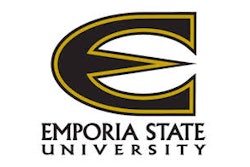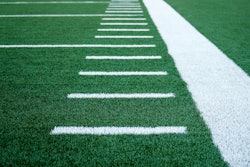Flexibility is key to the successful development of recreational trails.
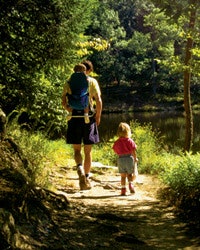
Smith doesn't necessarily prefer to operate on a piecemeal budget - he just doesn't have much choice. "With the budget constraints that we have, especially in recent years, other groups have stepped up to the plate to help fill in the gaps - with matching dollars, in-kind labor or even land purchases," he says, noting the significance of grant programs. "I find out about many of them through word of mouth. But a lot of it is paying attention to county, state and federal politics, because the grant programs drastically change. Sometimes, a program that would be really supportive of funding, say, off-road trails might switch its approach to streetscaping, which accommodates better sidewalks. Then you have to adapt."
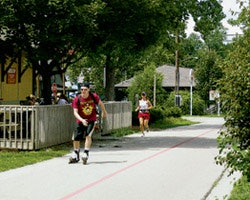
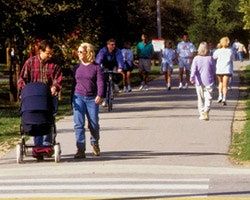
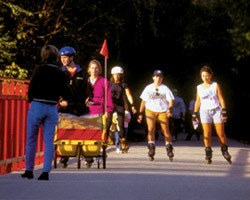
It would be at least another dozen years before Searns and his peers around the country received a significant boost, with the passage of the Intermodal Surface Transportation Efficiency Act of 1991. ISTEA (commonly pronounced "ice tea") represented the first major change to federal transportation planning and policy since the Interstate Highway System was created in 1956. The law introduced an intermodal approach to highway and transit funding, empowering metropolitan planning organizations to develop such alternative forms of local transportation as trails. "That was catalytic because communities would get some money from the feds and leverage it with local dollars," says Searns.
ISTEA expired in 1997 and was followed by the Transportation Equity Act for the 21st Century (TEA-21) and most recently in 2005, by the Safe, Accountable, Fair, Efficient Transportation Equity Act: A Legacy for Users (SAFETEA-LU), which will provide $286 billion for this country's transportation needs through fiscal year 2009. Of primary interest to trail advocates are several SAFETEA-LU programs - Transportation Enhancements, Congestion Mitigation and Air Quality, Scenic Byways and Recreational Trails - all of which are administered through state departments of transportation and feature a matching grant component (the federal funds match is determined by a sliding-scale formula, with the government's contribution not to exceed 95 percent). The Recreational Trails Program, for example, will make available $80 million in FY 2008.
Jeff Ciabotti, vice president of trail development for the Washington, D.C.-based nonprofit Rails-to-Trails Conservancy, credits recent federal transportation legislation with kick-starting a nationwide trail-building boom. "Wonderfully, the federal money is increasing with every reauthorization of the transportation bill," he says. "But also, many states have developed their own bond initiatives to purchase and develop these types of systems - Florida, Pennsylvania, Ohio and Wisconsin all have poured their own money into really strong statewide trails programs. Local communities, too, through bond and tax initiatives, are sometimes taxing themselves to raise the money in order to purchase and develop these types of facilities."
In Colorado, it was a voter-initiated program called Great Outdoors Colorado - a trust funded by 50 percent of Colorado Lottery proceeds - that paved the way for many open space, conservation and recreation projects, including trails. Since it began awarding grants in 1994, the trust has distributed almost $489 million among 2,100 projects statewide. Says Searns, "It enabled trails to take the great leap forward."

Indiana trail advocates' efforts have been bolstered by one research study after another, which reinforce Irvin's assertion that trails and greenways are much more than recreational necessities - they can help grow state and local economies. He cites the Monon Trail, a former railroad corridor that is now Indy Parks' flagship greenway, stretching 10 miles from downtown Indianapolis to the northern suburb of Carmel, where it connects with another five-mile greenway. Compared to property elsewhere in Indianapolis, values of land located within one half-mile of the trail have risen dramatically since the $9 million trail's first segment opened in 1996 - with some real estate developers paying as much as a 50 percent premium on land adjacent to the trail. "The Monon is in a very culturally active place that has a lot more businesses, coffee shops and restaurants," says Irvin, noting in particular one revitalized neighborhood. "In the Broad Ripple Village area, there were a lot of little houses along the way. Now they've all been turned into restaurants or bars, or in other areas, they've been torn down and developers are building condos that start at $250,000. The trail brings a lot of people to the area, and they want to stay there because of the surrounding activity. It's a winning combination."
Irvin hopes Indiana's trail-builders and agricultural producers can find similar harmony. As the biofuels industry gains momentum (Indiana is the United States' fifth-largest grower of corn), more questions are being asked about the potential costs of transporting ethanol and other biofuel products over long distances. Irvin is convinced that these materials, as well as utilities such as telecommunications and electricity, can be transported via pipes buried beneath trails spanning the state - at a fraction of the current cost to locate infrastructure beneath public roads. Communities could use the right-of-way or user fees charged to ethanol producers and utility companies to help pay for trail construction and maintenance. "We are running out of space to put infrastructure - plus it has gotten to be a tremendous cost every time we resurface streets or relocate manholes," says Irvin. "We can put these pipes underneath dedicated corridors with light traffic, so if we have to come in and take up a piece of trail, you're only talking three inches of asphalt and six inches of gravel, at the most. It becomes very economical and it's smart engineering."

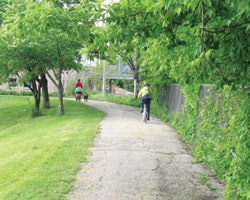
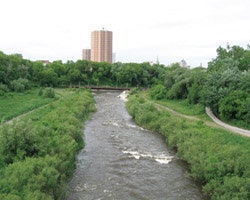
Since 1991, the Rails-to-Trails Conservancy has helped local governments and nonprofit organizations everywhere convert former rail lines passing through their communities into 1,422 recreational trails (see "Rail Links," next page). With the conservancy currently at work on 1,200 additional projects, Ciabotti is prompted to identify trails as an increasingly viable alternative form of everyday transportation. "We have somewhere close to 14,000 miles of open trails and another 14,000 in the project stage," he says. "In 10 to 15 more years, we could see 30,000 miles of trails on the ground. By comparison, it took 40 to 50 years to build 40,000 miles of our federal highway system. I don't know if a lot of people think about it that way. There's some real potential here."
The most ambitious use of trails yet may be in Atlanta, where a trail system is being employed as one of two catalysts for the city's 25-year economic development plan. Financed by revenues derived from an innovative tax allocation district, the $2.6 billion BeltLine will consist of a 22-mile loop around downtown and midtown Atlanta, using abandoned railroad corridors to pair recreation trails with transit lines crossing through 45 neighborhoods. The redevelopment of as many as 2,900 underutilized acres of land - including 1,300 acres into new greenspace, increasing the city's parkland by nearly 50 percent - is expected to bring 48,000 construction jobs. By project's end, an estimated 30,000 permanent jobs will have been created along the BeltLine, with new businesses expected to boost Atlanta's tax base by $20 billion. "It's not about building just one trail that goes from point A to point B," says Ciabotti. "How does that trail system connect to parks, schools, day-care centers and transit hubs? That's the key."
Of course, the success of such large-scale projects also hinges on the ability to foster long-term cooperation among people of various disciplines. "Bringing the transit engineers and the bike path designers together always takes overarching leadership," says Searns. "But I think we're starting to see that."
It has been seen in Milwaukee County, where the shots are called by a diverse volunteer trails council first convened by Smith three years ago, shortly after he accepted the newly created position of trails coordinator (he was promoted to deputy regional manager this spring). The council is made up of representatives from the county parks department, the state departments of natural resources and transportation, the city of Milwaukee and the county's other 18 municipalities, and local residents. Their first assignment, says Smith, was simply "to put together a well-established plan because one hadn't been done before."
Although it is a "living document" - "I still have a couple of tweaks to make," Smith says - that network trails plan could be adopted by the Milwaukee County Board of Supervisors as early as this fall. In the meantime, using the draft plan as his guide, Smith has set about enhancing a network of multiuse trails scattered throughout 15,000 acres of parkland. Now, Milwaukee County boasts a 108-mile trail that alternates between paved off-road paths, parkways and city streets; a variety of short fitness and hiking trails; birding and nature trails; snowmobile, cross-country skiing and equestrian trails; and a 25-mile "urban water trail" that allows paddlers to traverse the restored Milwaukee River from its mouth on Lake Michigan north through, first, a vibrant stretch of downtown skyline and, then, a serene Central Park-like oasis. Appropriately, a footpath accompanies the water route along each riverbank. "It's a really neat thing," says Smith, "because it gives people access and exposure to the river in a way I don't think they've had in years."
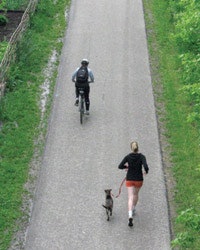
For instance, there was last year's construction of a 3¼4-mile soft-surface trail along the Milwaukee River's east bank that, because it helped preserve the river corridor, was partially paid for by a $90,000 state coastal management grant. In addition, county parks workers were assisted on the project by AmeriCorps volunteers, made available through a National Park Service program, and conservation crews of high school youths, whose summertime wages ($300,000 worth) were paid by a major automation controls company based in Milwaukee. Smith's powers of negotiation also were critical when it came time to convince private property owners along the Milwaukee River corridor to allow public access to a trail slicing through their land (its route alternates between county-owned and private property). "I should mention that building trails on our own land is a lot easier than building trails that require easements," says Smith, noting that one property owner, a paper manufacturer, agreed to the trail in exchange for the county's pledge to fence off and protect sensitive equipment from tampering. "Fortunately, those neighbors were fantastic to work with. But when you have to secure easements, it takes time. I guess that's just part of the process. That's what makes it all happen."

But where some might see evidence of decline, Jeff Ciabotti of the Rails-to-Trails Conservancy only sees opportunity. "The American people have made a substantial investment in this rail infrastructure," he says. "Once they're no longer used for active railroads, converting these rails into a different type of use is a great recycling program."
Converting abandoned rail corridors into trails has long been the most common means of trail acquisition and development. For the past 15 years, the Rails-to-Trails Conservancy (railstotrails.org) has been helping communities recycle rails in their backyards into trails and passive recreation areas (the typical railroad corridor is 100 feet wide, meaning that preserving one mile of corridor can yield 12 acres of open space). It primarily does so in two ways: The first involves the conservancy's "early warning system," which notifies communities that nearby rails are about to be abandoned by their operators. "When a railroad determines that its line is no longer feasible to operate, it has to go through a pretty substantial federal application process," says Ciabotti. "Shortly after the federal government is made aware, we usually get a notice that this opportunity is, shall we say, coming down the line. Our job is to then notify local communities - elected officials, parks department directors, trails advocates - and say, 'Hey, here's a line that's coming available in your area. If you're interested in converting it to a trail, this is how you do it and we're here to help.' "
At that point, the conservancy headquarters staff will turn matters over to its regional team of trail developers, who can provide tailored technical and planning assistance. Some communities need more help than others. "In some communities, we could be working with a nonprofit organization or a county government that has a trails person as part of its institutional infrastructure. So it has the capacity and sophistication level to carry the ball," says Ciabotti. "But for communities that don't have these opportunities, we'll get them on our web site, get them all the background information they'll need and provide as much technical assistance over the phone as we can. In some cases, we'll even work with the local community to find sources of money."
Other Trail Development Resources American Trails (americantrails.org): This national nonprofit organization's site features a "Resources & Library" section that offers summaries and comparisons of federal transportation funding programs and a comprehensive database of various types of trails nationwide - including the more than 900 specially designated National Recreation Trails.
Atlanta BeltLine (beltline.org): This site provides more information about the city's $2.6 billion rails-with-trails economic development project. Of particular interest is the BeltLine project's central funding mechanism, an innovative tax allocation district.
Indiana Department of Natural Resources, Division of Outdoor Recreation (in.gov/dnr/outdoor/planning/trailsplan/index.html): "Hoosiers on the Move," the state's 134-page trails, greenways and bikeways plan, can be downloaded here in its entirety.
Milwaukee County Trails (county.milwaukee.gov/trails8084.htm): In addition to providing construction cost estimates for various types of surfaces (gravel, asphalt and concrete), based on 2005 materials prices, the county parks department's network trails plan includes construction and maintenance guidelines that are in compliance with requirements of the Americans with Disabilities Act of 1990 and follow recommendations for bicycling facilities by the American Association of State Highway and Transportation Officials (AASHTO).



















